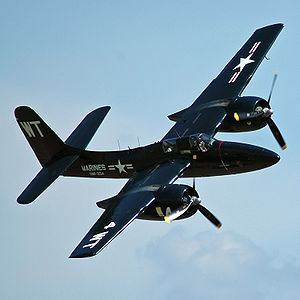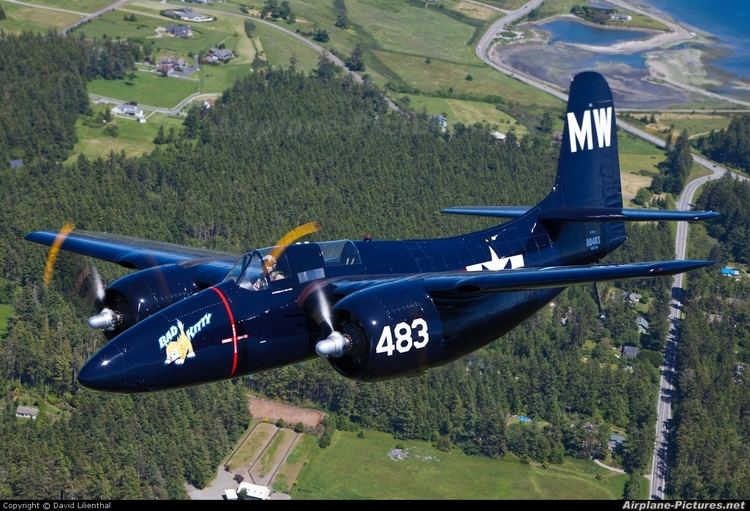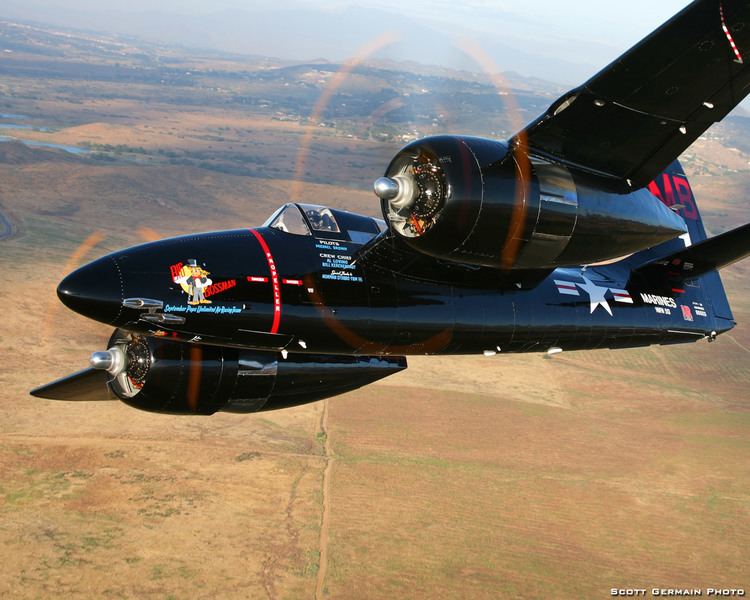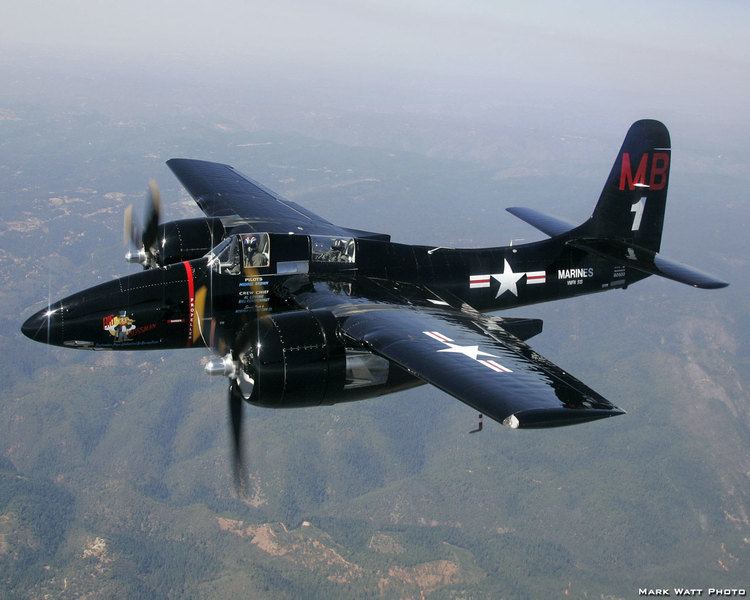Top speed 740 km/h Range 1,900 km Length 14 m | Wingspan 16 m Cruise speed 357 km/h | |
 | ||
Engine type Pratt & Whitney R-2800 Double Wasp | ||
Grumman f7f tigercat 1945
The Grumman F7F Tigercat is a heavy fighter aircraft that served with the United States Navy (USN) and United States Marine Corps (USMC) from late in World War II until 1954. It was the first twin-engined fighter to be deployed by the USN. While the Tigercat was delivered too late to see combat in World War II, it saw action as a night fighter and attack aircraft during the Korean War.
Contents
- Grumman f7f tigercat 1945
- Grumman f7f tigercat and f8f bearcat aviation day 2016
- Design and development
- Operational history
- Variants
- Operators
- Survivors
- Specifications F7F 4N Tigercat
- References

Designed initially for service on Midway-class aircraft carriers, early production F7Fs were land-based variants. The type was too large to operate from older and smaller carriers, and only a late variant (F7F-4N) was certified for carrier service.

Grumman f7f tigercat and f8f bearcat aviation day 2016
Design and development

Based on the earlier Grumman XP-50 that was eventually canceled, the company developed the XP-65 (Model 51) further for a future "convoy fighter" concept. In 1943, work on the XP-65 was terminated in favor of the design that would eventually become the F7F. The contract for the prototype XF7F-1 was signed on 30 June 1941. Grumman's aim was to produce a fighter that outperformed and outgunned all existing fighter aircraft, and that had an auxiliary ground attack capability. Armament was heavy: four 20 mm cannons and four 0.50 in (12.7 mm) machine guns, as well as underwing and under-fuselage hardpoints for bombs and torpedoes. Performance met expectations too; the F7F Tigercat was one of the highest performance piston-engined fighters, with a top speed well in excess of the US Navy's single-engined aircraft—71 mph faster than a Grumman F6F Hellcat at sea level. CAPT Fred M. Trapnell, one of the Navy's premier test pilots, opined that: "It's the best damn fighter I've ever flown." The Grumman F7F was originally named the "Tomcat" but this name was rejected as it was considered too suggestive, at the time. The name would much later be used for the Grumman F-14.
All this was bought at the cost of heavy weight and a high landing speed, but what caused the aircraft to fail carrier suitability trials was poor directional stability with only one engine operational, as well as problems with the arrestor hook design. The initial production series was therefore used only from land bases by the USMC, as night fighters with APS-6 radar. At first, they were single-seat F7F-1N aircraft, but after the 34th production aircraft, a second seat for a radar operator was added; these aircraft were designated F7F-2N.
The next version produced, the F7F-3, was modified to correct the issues that caused the aircraft to fail carrier acceptance and this version was again trialled on the USS Shangri-La. A wing failure on a heavy landing caused the failure of this carrier qualification too. F7F-3 aircraft were produced in day fighter, night fighter and photo-reconnaissance versions.
A final version, the F7F-4N, was extensively rebuilt for additional strength and stability, and did pass carrier qualification, but only 12 were built.
Operational history
Marine Corps night fighter squadron VMF(N)-513 flying F7F-3N Tigercats saw action in the early stages of the Korean War, flying night interdiction and fighter missions and shooting down two Polikarpov Po-2 biplanes. This was the only combat use of the aircraft.
Most F7F-2Ns were modified to control drones for combat training, and these gained bubble canopies over the rear cockpit for the drone controller. An F7F-2D used for pilot transitoning also had a rear sliding, bubble canopy.
In 1945, two Tigercats, serialled TT346 and TT349, were evaluated, but rejected, by the British Royal Navy, who preferred a navalized version of the de Havilland Hornet.
Variants
Operators
Survivors
Beginning in 1949, F7Fs were flown to the then-US Navy storage facility at Naval Air Station Litchfield Park, Arizona. Although the vast majority of the airframes were eventually scrapped, a number of examples were purchased as surplus. The surviving Tigercats were primarily used as water bombers to fight forest fires in the 1960s and 1970s and Sis-Q Flying Services of Santa Rosa, California operated an F7F-3N tanker in this role until retirement in the late 1980s.
Specifications (F7F-4N Tigercat)
Data from Jane's Fighting Aircraft of World War II
General characteristics
Performance
Armament
Avionics
